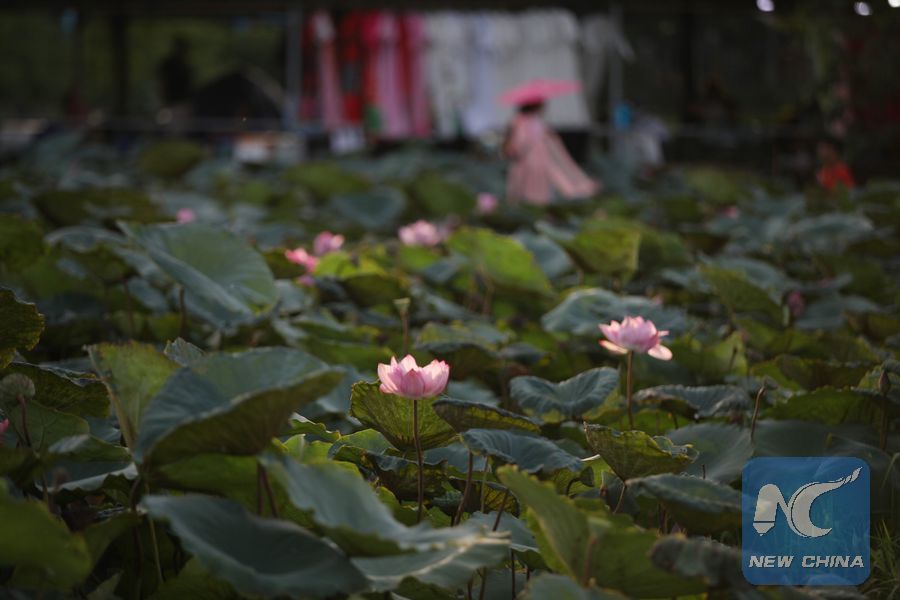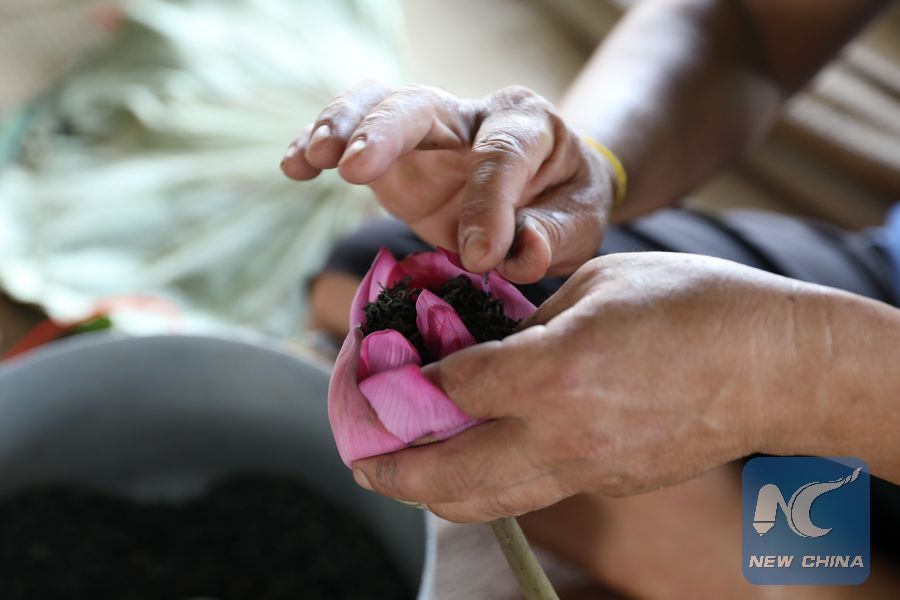
Photo taken on July 5, 2019 shows a woman holding a lotus bouquet in Hanoi, Vietnam. (Xinhua/Wang Di
By Wang Di, Bui Long
HANOI, July 7 (Xinhua) -- Dozens of Vietnamese and foreign people, mostly women were sitting on small boats or walking on bamboo bridges in the middle of a big pond full of pink lotus flowers in Vietnam's capital Hanoi.
"The lotus season lasts for only two summer months, but always attracts a plethora of local and foreign visitors. Our lotus pond used to receive up to 700 people on a single day," Nguyen Duc Chung, owner of a 6.2-hectare lotus pond adjacent to the West Lake in Hanoi's Tay Ho district, told Xinhua recently.
Despite the scorching sun in early July, most of the female visitors dressed in "ao dai", Vietnam's traditional long dress, or "ao yem", the country's ancient camisole, tirelessly posed for photos with pink lotus flowers and green lotus leaves, while male visitors sat in a hut on the verge of the pond, drinking fragrant lotus tea or lotus wine and chatting with Chung and his relatives.

Photo taken on July 5, 2019 shows lotus flowers in blossom in a pond adjacent to the West Lake in Hanoi, Vienam. (Xinhua/Wang Di)
"We, farmers, are deeply indebted to lotuses for their great help. They have not only profound cultural meaning but also high economic value," Chung said, noting that every part of a lotus plant, including its flowers, leaves and roots, can be made into either tasty foods or herbal medicines.
Lotus symbolizes bright, noble and pure beauty and is considered as Vietnam's national flower by most of the local people, although the state has yet to issue any legal documents to officially recognize that.
"Nothing is more beautiful than the lotus in the pond. Green leaves, white flowers, yellow stamens. Yellow stamens, white flowers, green leaves. Near mud but it does not stink like mud," Chung, the 54-year-old farmer with a weather-beaten face, proudly recited folk verses which are known by most of the Vietnamese people.
Lotus plants, whose flowers are either pink or white, have been widely grown in shallow and murky waters in some Asian countries such as China and Vietnam for millenniums. Its vitality and beauty above murky waters, its bright color and pleasant scent, have become icons in literature, arts and religions, including Buddhism.
In 2010-2011, the Vietnamese Ministry of Culture, Sports and Tourism launched a national flower voting in northern, central and southern regions, and lotus always gained the highest vote, tailed by apricot blossom and peach blossom.
"Apricot blossom is very beautiful but is endemic in the southern region, and peach blossom is also very beautiful but is endemic in the northern region... Our national flower should symbolize Vietnamese people's spirit and consciousness," President of the Association of Vietnamese Folklorists To Ngoc Thanh said, that's why he chose lotus.
According to him, besides its cultural and aesthetic beauties, lotus has high economic value, with stamens bringing fragrance to tea, seeds being made into jams, cakes and tranquilizers, rhizomes being consumed as a vegetable, and leaves being used as a natural wrap.
"We sell a fresh lotus leave for 1,000 to 2,000 Vietnamese dong (about 4 to 8 U.S. cents), a flower for 10,000 Vietnamese dongs (about 40 U.S. cents), and a flower with tea inside for 30,000 Vietnamese dongs (about 1.3 U.S. dollars," Chung told Xinhua.

Photo taken on July 5, 2019 shows people making lotus tea in Hanoi, Vietnam. (Xinhua/Wang Di)
Sitting next to Chung in the hut is his nephew named Tuan, who was busy putting dried tea into lotus flowers and wrap them with lotus leaves. "Each day, I harvest some 500 to 600 lotus flowers to sell them as fresh flowers or lotus tea," the young man said.
Gracefully walking barefoot on a bamboo bridge to the pond's center to take the best photos of pink lotuses, a local student of photography named Truc Quynh said she would post them on social media platforms to promote the flower. "I will try my best to be compared with a lotus flower which always retains its beauty and dignity despite adversity," she said, blossoming into a charming smile.

